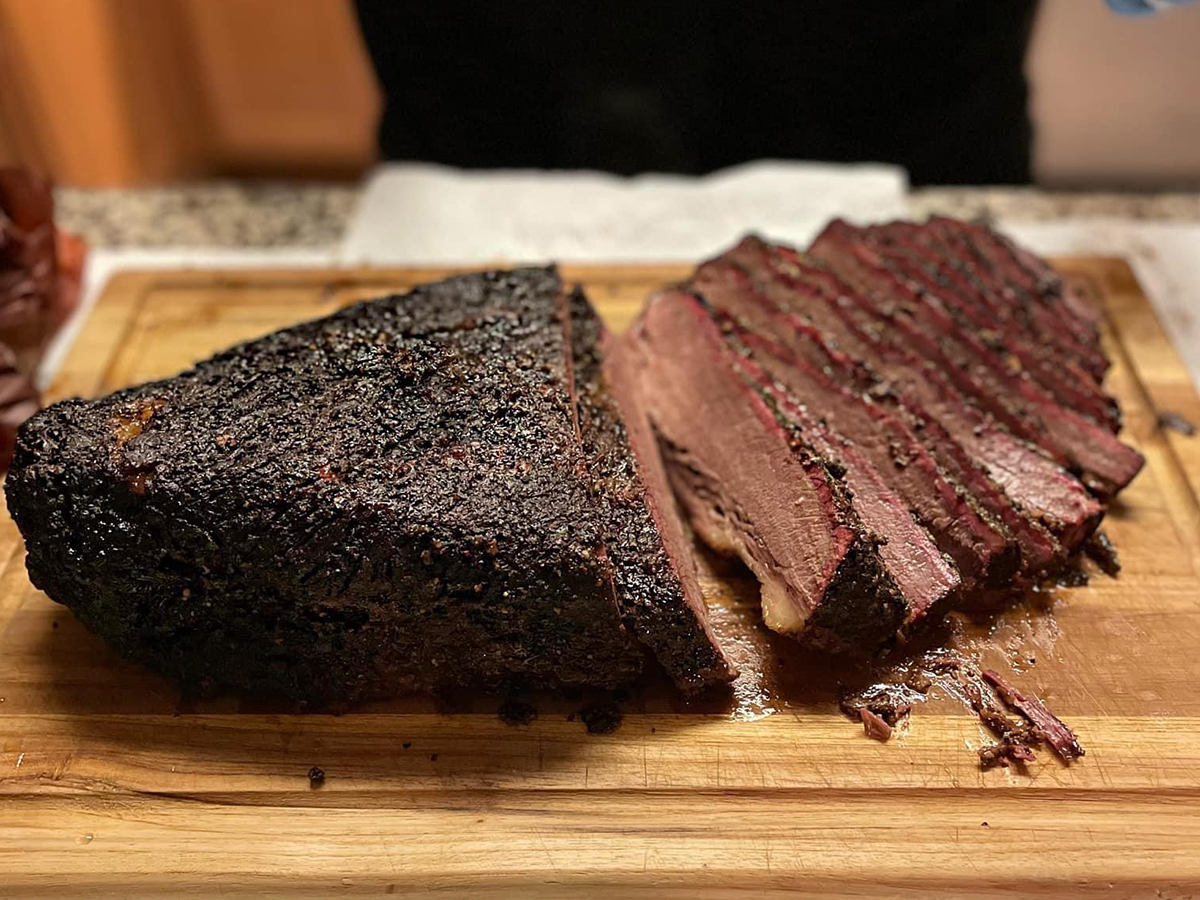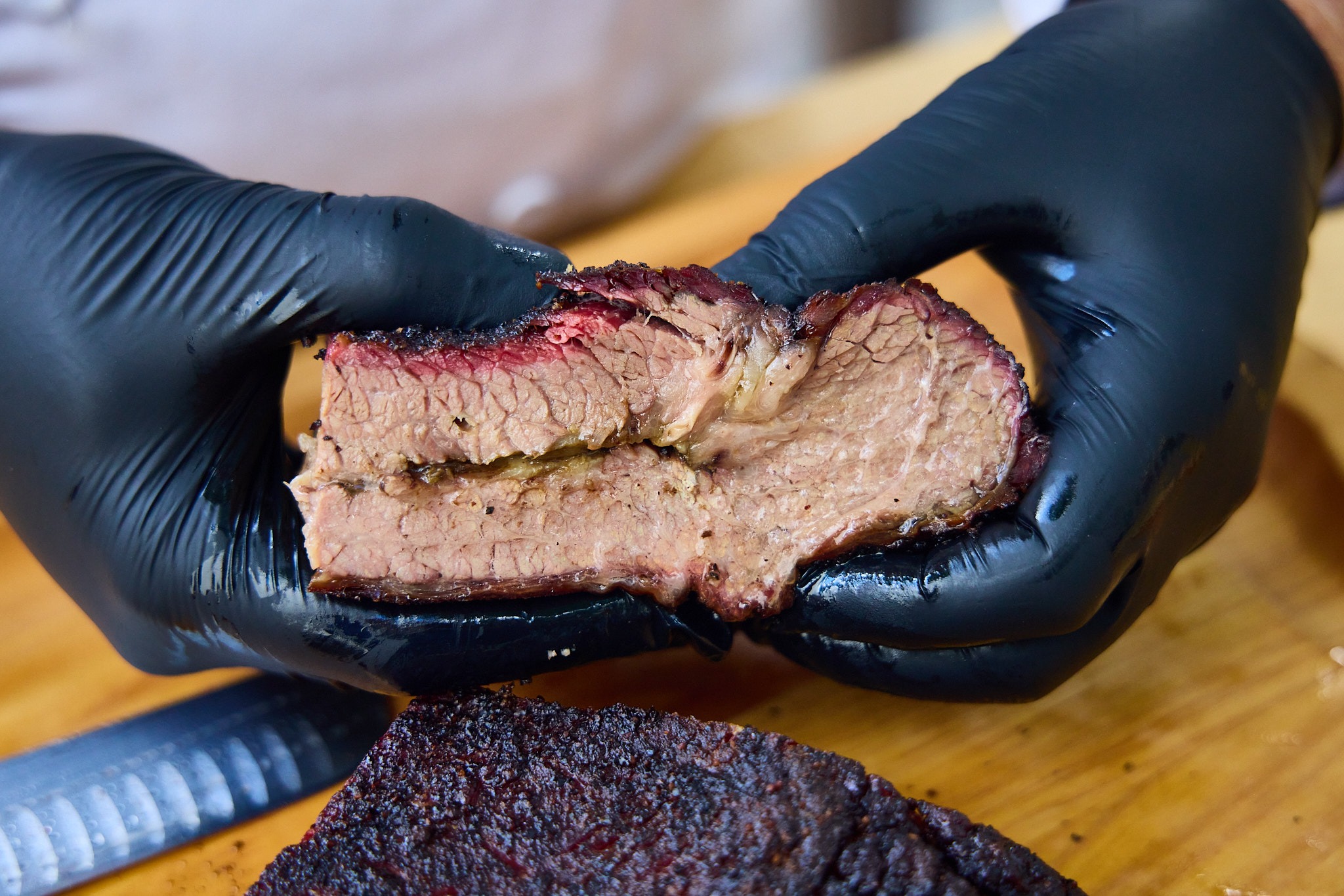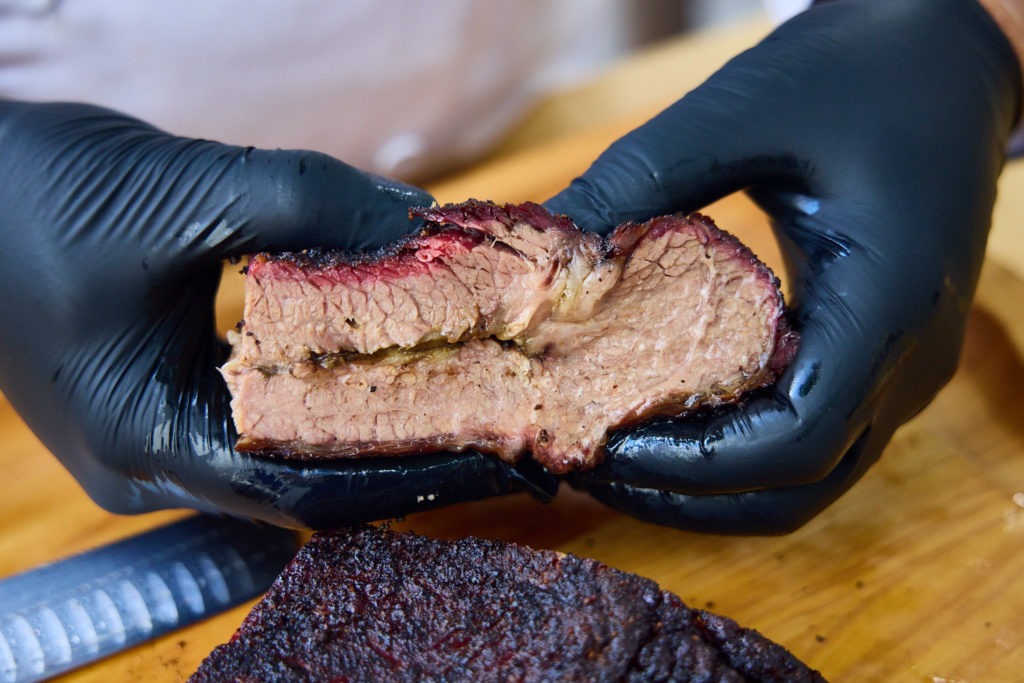
Introduction
Background Information On Pulling Brisket And The Importance Of Determining The Optimal Temperature
Pulling brisket off the grill at the right temperature is crucial for achieving a tender, juicy, and flavorful bite. The internal temperature is a key factor that determines the meat’s tenderness, juiciness, and overall quality. Whether you are a professional pitmaster or a backyard grilling enthusiast, understanding the significance of the internal temperature and knowing what temperature to pull brisket off the grill is essential for a delicious final result.
To understand the importance of the internal temperature, let’s delve into some background information. When cooking brisket, the meat undergoes a process called collagen breakdown. Collagen is a tough protein found in connective tissues, which makes the meat initially tough and chewy. However, when the collagen breaks down during cooking, it transforms into gelatin, resulting in a tender and succulent texture.
The collagen breakdown process is temperature-dependent. It starts to occur at around 160°F (71°C) and continues until it reaches a peak at around 190°F (88°C). At this point, most of the collagen has converted into gelatin, and the meat becomes extremely tender. However, if the beef is cooked beyond this temperature, it can become dry and lose its juiciness.
To ensure the optimum tenderness and juiciness of your brisket, it is crucial to pull it off the grill at the right internal temperature. The ideal temperature range for pulling brisket is between 195°F (90°C) and 205°F (96°C). Within this range, the collagen has broken down sufficiently, resulting in a melt-in-your-mouth texture.
Monitoring the internal temperature is essential to avoid undercooking or overcooking the brisket. Using a reliable meat thermometer, insert it into the thickest part of the meat without touching the bone. Once the internal temperature reaches around 195°F (90°C), you can start checking for tenderness by probing the meat with a fork. If it easily slides in and out without resistance, the brisket is ready to be pulled off the grill.
In conclusion, pulling brisket off the grill at the right temperature is crucial for achieving tender, juicy, and flavorful results. Understanding the significance of the internal temperature and knowing what temperature to pull brisket off the grill can make a significant difference in the overall quality of the meat. With practice and experience, you can develop the skill to determine the optimal internal temperature, resulting in a delicious brisket every time.
What Is Brisket Cooking Temperature
Understanding The Ideal Temperature Range For Cooking Brisket
To achieve a tender, juicy, and flavorful brisket, it is crucial to understand the ideal cooking temperature range. The internal temperature of the brisket plays a significant role in determining its tenderness and overall quality.
When cooking brisket, the tough collagen protein found in connective tissues breaks down into gelatin at specific temperatures. This collagen breakdown process starts around 160°F (71°C) and peaks at around 190°F (88°C). At this point, most of the collagen has transformed into gelatin, resulting in a tender and succulent texture. However, cooking the beef beyond this temperature can lead to dryness and loss of juiciness.
To ensure the optimum tenderness and juiciness of your brisket, it is recommended to cook it within the temperature range of 195°F (90°C) to 205°F (96°C). Within this range, the collagen has sufficiently broken down, resulting in a melt-in-your-mouth texture.
Monitoring the internal temperature is essential to avoid undercooking or overcooking the brisket. Use a reliable meat thermometer and insert it into the thickest part of the meat without touching the bone. Once the internal temperature reaches around 195°F (90°C), check for tenderness by probing the meat with a fork. If it easily slides in and out without resistance, the brisket is ready to be pulled off the grill.
It is important to note that there is some variation in expert opinions regarding the ideal cooking temperature for brisket. However, the majority agree on the range of 195°F (90°C) to 205°F (96°C) as the sweet spot for achieving a perfectly cooked brisket.
In summary, understanding the ideal temperature range for cooking brisket is vital for achieving tender, juicy, and flavorful results. Cooking within the range of 195°F (90°C) to 205°F (96°C) allows the collagen to break down and transform into gelatin, resulting in a delicious brisket. Proper temperature monitoring and tenderness testing will help you determine the optimal moment to pull the brisket off the grill for a mouthwatering final result.
Factors Affecting Brisket Temperature Range
Exploring The Various Factors That Can Influence The Temperature Range For Pulling Brisket
While the recommended temperature range for pulling brisket off the grill falls between 195°F (90°C) to 205°F (96°C), it’s important to note that several factors can affect the cooking process and the optimal internal temperature for a perfectly cooked brisket. Here are some of the key factors to consider:
- Cut and thickness: The thickness and cut of the brisket can impact the cooking time and temperature needed to achieve the desired tenderness. Thicker cuts may require a slightly higher internal temperature to fully break down the collagen and achieve optimal texture.
- Smoker or grill temperature: The temperature of your smoker or grill plays a crucial role in determining how long it takes for the brisket to reach the desired internal temperature. Maintaining a consistent temperature throughout the cooking process is essential for even cooking and optimal results.
- Resting period: After pulling the brisket off the grill, it’s recommended to let it rest for a period of time. During this resting period, the residual heat continues to cook the meat and allows the juices to redistribute, resulting in a moist and flavorful brisket. The internal temperature may continue to rise slightly during this resting period.
- Desired texture: The texture preference can vary among individuals. Some may prefer a softer, fork-tender brisket, while others may prefer a firmer texture. This can influence the internal temperature at which you choose to pull the brisket off the grill.
It’s important to consider these factors and make adjustments accordingly to achieve the desired results when cooking brisket. Keep in mind that practice and experience play a significant role in mastering the art of cooking brisket to perfection. With time, you’ll develop a better understanding of these factors and be able to consistently achieve a tender, juicy, and flavorful brisket.

Expert Opinions On Brisket Pulling Temperature
Insights And Recommendations From BBQ Legends And Experts On The Optimal Temperature To Pull Brisket
While the recommended temperature range for pulling brisket off the grill falls between 195°F (90°C) to 205°F (96°C), several factors can influence the cooking process and the optimal internal temperature for a perfectly cooked brisket. BBQ legends and experts have shared their insights and recommendations on when to pull brisket off the grill:
- Aaron Franklin: Renowned pitmaster Aaron Franklin suggests pulling brisket off the grill when the internal temperature reaches around 203°F (95°C). According to Franklin, this temperature allows the collagen in the meat to fully break down, resulting in a tender and moist brisket.
- Tuffy Stone: BBQ champion Tuffy Stone advises pulling brisket off the grill at an internal temperature of 200°F (93°C) to 205°F (96°C). Stone believes that hitting the sweet spot within this temperature range ensures a tender, flavorful, and well-rendered brisket.
- Meathead Goldwyn: BBQ expert Meathead Goldwyn recommends pulling brisket off the grill once the internal temperature reaches around 195°F (90°C) and letting it rest until it reaches 200°F (93°C). This allows the residual heat to continue cooking the meat and improves its texture and moisture.
These experts highlight the importance of achieving the right temperature range for pulling brisket off the grill. They emphasize the need for patience and understanding of the cooking process to ensure a successfully cooked brisket that is tender, juicy, and packed with flavor.
Remember, the recommended temperature range serves as a starting point, but adjustments may be necessary based on personal preference, cut and thickness of the brisket, smoker or grill temperature, and desired texture. Practice and experience will help you fine-tune the process and consistently achieve exceptional results with your brisket.
By incorporating the insights and recommendations from these BBQ legends and experts, you can enhance your brisket cooking skills and create a mouthwatering culinary masterpiece that will impress your guests and leave them craving for more.
Testing And Experimentation
The Results Of Testing Different Combinations Of Timings, Temperatures, And Wrapping Methods For Brisket
In the pursuit of a perfectly cooked brisket, many pitmasters have conducted extensive testing and experimentation to find the optimal combination of timings, temperatures, and wrapping methods. These tests provide valuable insights into the cooking process and can help guide your decision on when to pull brisket off the grill.
When conducting these tests, pitmasters take into account factors such as tenderness, juiciness, flavor, and bark development. They carefully monitor the internal temperature of the brisket at various stages to determine the ideal point for pulling it off the grill.
One common finding among these tests is that the optimal temperature range for pulling brisket off the grill falls between 195°F (90°C) to 205°F (96°C). Within this range, the collagen in the meat breaks down, resulting in a tender and moist brisket.
However, it’s important to note that individual preferences and variables such as the size and quality of the meat, smoker or grill temperature, and desired texture can influence the exact temperature at which to pull brisket off the grill.
Renowned pitmaster Aaron Franklin suggests pulling brisket off the grill when the internal temperature reaches around 203°F (95°C). BBQ champion Tuffy Stone advises hitting the sweet spot within a temperature range of 200°F (93°C) to 205°F (96°C). BBQ expert Meathead Goldwyn recommends pulling brisket off the grill at around 195°F (90°C) and letting it rest until it reaches 200°F (93°C).
These expert opinions serve as a valuable starting point for your experimentation. By testing different combinations of timings, temperatures, and wrapping methods, you can find the perfect balance that suits your taste and cooking style.
Through practice and experience, you can develop the skills to consistently achieve a tender, juicy, and flavorful brisket. So don’t be afraid to experiment and make adjustments until you find the ideal temperature to pull your brisket off the grill.
Remember, the journey to the perfect brisket is a personal one, and with each test, you will inch closer to mastering this beloved barbecue dish. Happy grilling!
What Internal Temperature To Pull Brisket Off The Smoker
Examining The Recommendation From The BBQ Legend On The Temperature At Which Brisket Should Be Pulled
The quest for perfectly cooked brisket has led many pitmasters to conduct extensive testing and experimentation. Through these tests, they have discovered the optimal combination of timings, temperatures, and wrapping methods for achieving tender and juicy brisket. One common finding among these tests is that the ideal temperature range for pulling brisket off the grill falls between 195°F (90°C) to 205°F (96°C).
However, it’s important to note that individual preferences and variables such as the size and quality of the meat, smoker or grill temperature, and desired texture can influence the exact temperature at which to pull brisket off the grill. Renowned pitmaster Aaron Franklin suggests pulling brisket off the grill when the internal temperature reaches around 203°F (95°C), while BBQ champion Tuffy Stone advises hitting the sweet spot within a range of 200°F (93°C) to 205°F (96°C). Meanwhile, BBQ expert Meathead Goldwyn recommends pulling brisket off the grill at around 195°F (90°C) and letting it rest until it reaches 200°F (93°C).
These expert opinions can serve as a starting point for your own experimentation. By testing different combinations of timings, temperatures, and wrapping methods, you can find the perfect balance that suits your taste and cooking style. Remember, the journey to the perfect brisket is a personal one, and with each test, you will inch closer to mastering this beloved barbecue dish.
In conclusion, pulling brisket off the grill at the right temperature is crucial in achieving a tender, juicy, and flavorful bite. While the recommended temperature range falls between 195°F (90°C) to 205°F (96°C), individual preferences and variables can influence the exact temperature. With practice and experience, you can develop the skills to consistently achieve a delicious brisket. So don’t be afraid to experiment and make adjustments until you find the ideal temperature to pull your brisket off the grill. Happy grilling!

Timing, Internal Temp & Wrapping
Understanding The Relationship Between Timing, Internal Temperature, And Wrapping When Pulling Brisket
When it comes to cooking the perfect brisket, understanding the relationship between timing, internal temperature, and wrapping is crucial. Finding the right balance will result in a tender and juicy brisket with a crispy bark. Let’s take a closer look at each of these factors and how they affect the final outcome.
Timing:
The timing of your brisket cook is essential to achieve the desired doneness. Cooking too short or too long can result in an undercooked or overcooked brisket. The general rule of thumb is to allocate around 1 hour and 15 minutes of cooking time per pound of brisket. However, it’s important to remember that every piece of meat is different, so adjust your timing accordingly.
Internal Temperature:
The internal temperature of the brisket is a critical factor in determining when to pull it off the smoker. The ideal range for pulling brisket off the grill falls between 195°F (90°C) to 205°F (96°C). This range ensures that the brisket is cooked to perfection, tender and moist. However, individual preferences and variables may influence the exact temperature at which you prefer to pull your brisket. Renowned pitmasters have different opinions on this matter, with Aaron Franklin suggesting around 203°F (95°C), Tuffy Stone advising a range of 200°F (93°C) to 205°F (96°C), and Meathead Goldwyn recommending pulling at around 195°F (90°C) and letting it rest until it reaches 200°F (93°C).
Wrapping:
Wrapping the brisket during the cooking process can help retain moisture and speed up the cooking time. The most common method is to wrap the brisket in butcher paper or aluminum foil once it reaches the desired level of bark formation. Wrapping helps tenderize the meat and prevents it from drying out. However, it can also soften the bark, so consider this factor when deciding whether to wrap or not.
In conclusion, finding the right timing, internal temperature, and wrapping method is key to achieving a juicy and flavorful brisket. While the recommended internal temperature range falls between 195°F (90°C) to 205°F (96°C), it’s important to consider individual preferences and variables. With practice and experimentation, you’ll develop your own technique to consistently cook a delicious brisket. Enjoy the journey and happy grilling!
Insider Knowledge And Tips
Sharing Insider Knowledge And Tips For Achieving The Perfect Pulled Brisket
When it comes to cooking the perfect brisket, there are several factors that come into play. Timing, internal temperature, and wrapping all play a crucial role in determining the tenderness and juiciness of the final product. Here are some insider tips to help you achieve the best results:
Timing:
Timing is crucial when cooking a brisket. While the general rule of thumb is to cook for around 1 hour and 15 minutes per pound of meat, it’s important to remember that every brisket is different. Factors such as size and thickness can impact cooking time. Make sure to adjust your timing accordingly to ensure that the brisket is neither undercooked nor overcooked.
Internal Temperature:
The internal temperature of the brisket is an important indicator of when it is ready to be pulled off the smoker. The recommended range for pulling brisket off the grill is between 195°F (90°C) to 205°F (96°C). This temperature range ensures that the connective tissue in the brisket has broken down, resulting in a tender and moist meat. However, it’s important to note that individual preferences and variables may influence the desired temperature. Renowned pitmasters have varying opinions on this matter, with some suggesting slightly different temperature ranges.
Wrapping:
Wrapping the brisket during the cooking process can have its benefits. It helps retain moisture and can speed up the cooking time. The most common method of wrapping is to use butcher paper or aluminum foil once the desired bark formation has been achieved. Wrapping helps tenderize the meat and prevents it from drying out. However, it’s important to consider that wrapping can also soften the bark, so make your decision based on your preferences.
In conclusion, achieving the perfect pulled brisket requires finding the right balance between timing, internal temperature, and wrapping. Experimentation and practice are key to developing your own technique. With these insider tips, you’ll be well-equipped to cook a delicious and flavorful brisket. Get ready to impress your family and friends with your barbecue skills!
Insider Knowledge And Tips
Sharing Insider Knowledge And Tips For Achieving The Perfect Pulled Brisket
When it comes to cooking the perfect brisket, several factors come into play. Timing, internal temperature, and wrapping all play a crucial role in determining the tenderness and juiciness of the final product. Here are some insider tips to help you achieve the best results:
Timing
Timing is crucial when cooking a brisket. While the general rule of thumb is to cook for around 1 hour and 15 minutes per pound of meat, it’s important to remember that every brisket is different. Factors such as size and thickness can impact cooking time. Make sure to adjust your timing accordingly to ensure that the brisket is neither undercooked nor overcooked.
Internal Temperature
The internal temperature of the brisket is an important indicator of when it is ready to be pulled off the smoker. The recommended range for pulling brisket off the grill is between 195°F (90°C) to 205°F (96°C). This temperature range ensures that the connective tissue in the brisket has broken down, resulting in a tender and moist meat. However, it’s important to note that individual preferences and variables may influence the desired temperature.
Wrapping
Wrapping the brisket during the cooking process can have its benefits. It helps retain moisture and can speed up the cooking time. The most common method of wrapping is to use butcher paper or aluminum foil once the desired bark formation has been achieved. Wrapping helps tenderize the meat and prevents it from drying out. However, it’s important to consider that wrapping can also soften the bark, so make your decision based on your preferences.
In conclusion, to achieve the perfect pulled brisket, finding the right balance between timing, internal temperature, and wrapping is crucial. Experimentation and practice are key to developing your own technique. With these insider tips, you’ll be well-equipped to cook a delicious and flavorful brisket. So, get ready to impress your family and friends with your barbecue skills!
FAQ: What Temp to Pull Brisket: Pulled Perfection – Determining the Optimal Temperature to Pull Brisket
Q: How do I determine the optimal temperature to pull brisket?
A: The optimal temperature to pull brisket can vary depending on personal preference and the tenderness you desire. However, in general, the ideal temperature range for pulling brisket falls between 195°F and 205°F (90°C to 96°C).
Q: Why is the temperature range important?
A: Brisket is made up of tough muscle fibers and connective tissues that need to be broken down through a process called collagen conversion. This process occurs as the brisket cooks low and slow, and it can take time to achieve the desired tenderness. The stretch between 195°F and 205°F is typically when the collagen converts into gelatin, resulting in tender and juicy meat that easily falls apart when pulled.
Q: Can I pull the brisket off the heat before it reaches the ideal temperature range?
A: It is generally recommended to wait until the brisket reaches the desired temperature range before pulling it off the heat. While the meat may be cooked and safe to eat at lower temperatures, it may not have reached the optimal tenderness for effortless pulling. Patience is key in achieving the best results.
Q: How can I check the temperature of the brisket?
A: Using a reliable meat thermometer is crucial for determining the internal temperature of your brisket. Insert the thermometer probe into the thickest part of the meat without touching the bone. Be mindful of hot spots in the smoker or grill that may affect the accuracy of the thermometer reading.
Q: Is the temperature the only indicator of when to pull the brisket?
A: While temperature is a significant factor, it’s not the only indicator you should rely on. Another essential aspect is the tenderness of the meat. You can check this by using a meat probe or a toothpick, which should slide smoothly into the thickest part of the brisket without much resistance when it’s done.
Q: What if I accidentally overcook the brisket?
A: If you find that you’ve gone past the optimal temperature and the brisket feels too soft or mushy, don’t panic. You can still salvage the situation by allowing the meat to rest and then slicing it instead of pulling. Slicing will help maintain some structure and prevent it from falling apart completely.
Q: How long should I let my brisket rest after pulling?
A: After the brisket reaches the desired temperature range, it’s crucial to let it rest for about 30 minutes to an hour before pulling. This resting period allows the juices to redistribute throughout the meat, resulting in a more flavorful and moist brisket.
Q: Do other factors affect the tenderness of the brisket, apart from temperature?
A: Yes, several factors can influence the tenderness of your brisket. These include the quality of the meat, the cooking method, the seasoning rub or marinade used, and the overall cooking time. It’s important to experiment with different techniques and adjust cooking times to find what works best for you.
Remember, determining the optimal temperature to pull brisket is a personal preference, and it may take some trial and error to find the sweet spot that suits your taste. Enjoy the process, embrace the smoky aroma, and savor the end result of your perfectly pulled brisket!

Noel Martinez, the owner of theholygrillsf.com, uses social media to connect with the community and share delicious updates from The Holy Grill. Follow Noel Martinez for mouthwatering food photos, exciting event announcements, and behind-the-scenes glimpses into the world of The Holy Grill. Stay in the loop and never miss out on the latest culinary adventures!